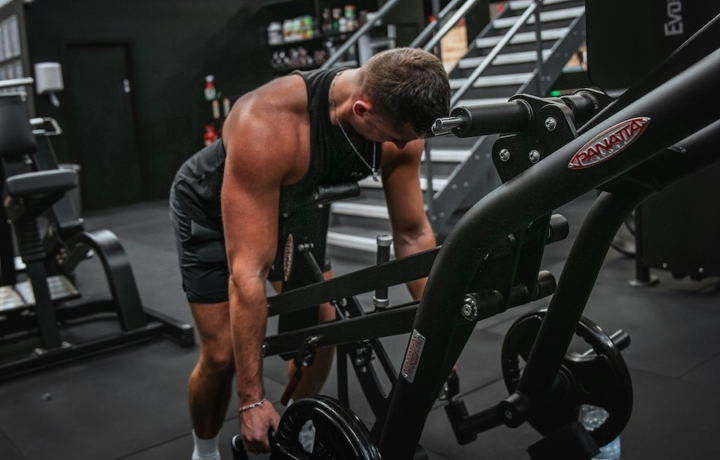Exercise
Chin-Up

Chin-Up
How to Perform
- Position yourself below a pull-up bar with an underhand grip (palms facing toward you) at approximately shoulder-width apart.
- Hang with arms fully extended, keeping your shoulders engaged and away from your ears while maintaining a slight hollow body position.
- Initiate the movement by pulling your shoulder blades down and back, creating tension in your upper back before bending your elbows.
- Exhale as you pull your body upward by driving your elbows down toward your ribs, maintaining a neutral spine throughout the movement.
- Continue pulling until your chin clears the bar, keeping your chest up and avoiding excessive neck extension to reach the bar.
- Pause briefly at the top position, squeezing your back muscles while maintaining control of your body position.
- Inhale as you lower yourself with control, extending your arms gradually without allowing your shoulders to shrug up toward your ears.
- Once you reach the starting position with arms fully extended, maintain tension in your upper back before beginning the next repetition.
Important information
- Keep your core engaged throughout the entire movement to prevent swinging or excessive arching of your lower back.
- If you cannot perform a full chin-up, use an assisted chin-up machine or resistance bands for support until you develop sufficient strength.
- Focus on quality over quantity – a few well-executed chin-ups are more beneficial than many performed with poor form.
- Avoid jerking or kipping movements that use momentum rather than muscle strength to complete the exercise.

Chin-Up
Exercise Details
Primary Muscles
Muscle Groups
Mechanic
Risk Areas
Built for progress
Take the guesswork out of training
Create personalized AI-powered workout plans that evolve with you. Train smarter, track every rep and keep moving forward, one workout at a time.






The chin-up stands as one of the most effective upper body exercises in your fitness arsenal, delivering impressive results for intermediate lifters looking to build both aesthetic appeal and functional strength. This compound movement primarily targets your latissimus dorsi (lats), creating that coveted V-taper physique, while simultaneously engaging your biceps and forearms for comprehensive development. Unlike its cousin the pull-up, the chin-up's underhand grip places greater emphasis on your biceps, making it particularly valuable for bodybuilding enthusiasts seeking balanced arm development. The exercise creates significant time under tension for these muscle groups, stimulating the hypertrophy necessary for visible muscle growth. Your forearms also receive substantial work as they struggle to maintain your grip throughout the movement, developing that rugged forearm definition many fitness enthusiasts pursue. What makes chin-ups particularly effective is their versatility across training modalities.
In traditional strength programming, weighted chin-ups serve as a primary vertical pulling movement, building raw pulling power that transfers to numerous real-world activities. When incorporated into HIIT workouts, chin-ups elevate your heart rate while simultaneously building upper body strength, offering an efficient approach to training that maximizes your time investment. The benefits extend beyond mere aesthetics. Regular chin-up practice improves shoulder stability, enhances grip strength that carries over to other lifts, and develops the posterior chain muscles often neglected in typical training programs.
Research consistently demonstrates that compound pulling movements like chin-ups stimulate greater hormonal responses compared to isolation exercises, potentially enhancing overall muscle growth throughout your physique. For intermediate lifters, chin-ups represent a perfect challenge: demanding enough to stimulate continued adaptation but achievable with consistent practice. Whether your goal is developing an impressive back, building functional strength, or creating a comprehensive upper body training program, the chin-up deserves a permanent place in your exercise rotation.
FAQ - Chin-Up
Chin-ups use an underhand (supinated) grip with palms facing you, while pull-ups use an overhand (pronated) grip. Chin-ups place more emphasis on the biceps and are generally easier for beginners, while pull-ups target the lats more directly.
Start with negative chin-ups (jumping to the top position and lowering slowly), assisted chin-ups using bands or a machine, or inverted rows. Progressive overload by reducing assistance over time until you can perform unassisted reps.
Most intermediate male lifters should aim for 8-12 clean reps, while female lifters might target 5-8 reps. Focus on perfect form rather than hitting arbitrary numbers, and consider adding weight once you can perform 12+ consecutive reps.
The biggest mistakes include insufficient range of motion (not going to full extension or chin over bar), excessive kipping/swinging, and leading with the chin instead of the chest. Always maintain control throughout the movement and avoid jerky motions that can stress your shoulders.
For optimal results, perform chin-ups 2-3 times weekly with at least 48 hours between sessions for recovery. You can alternate between higher volume days (more sets/reps) and strength-focused days (weighted variations) to maximize both hypertrophy and strength gains.







